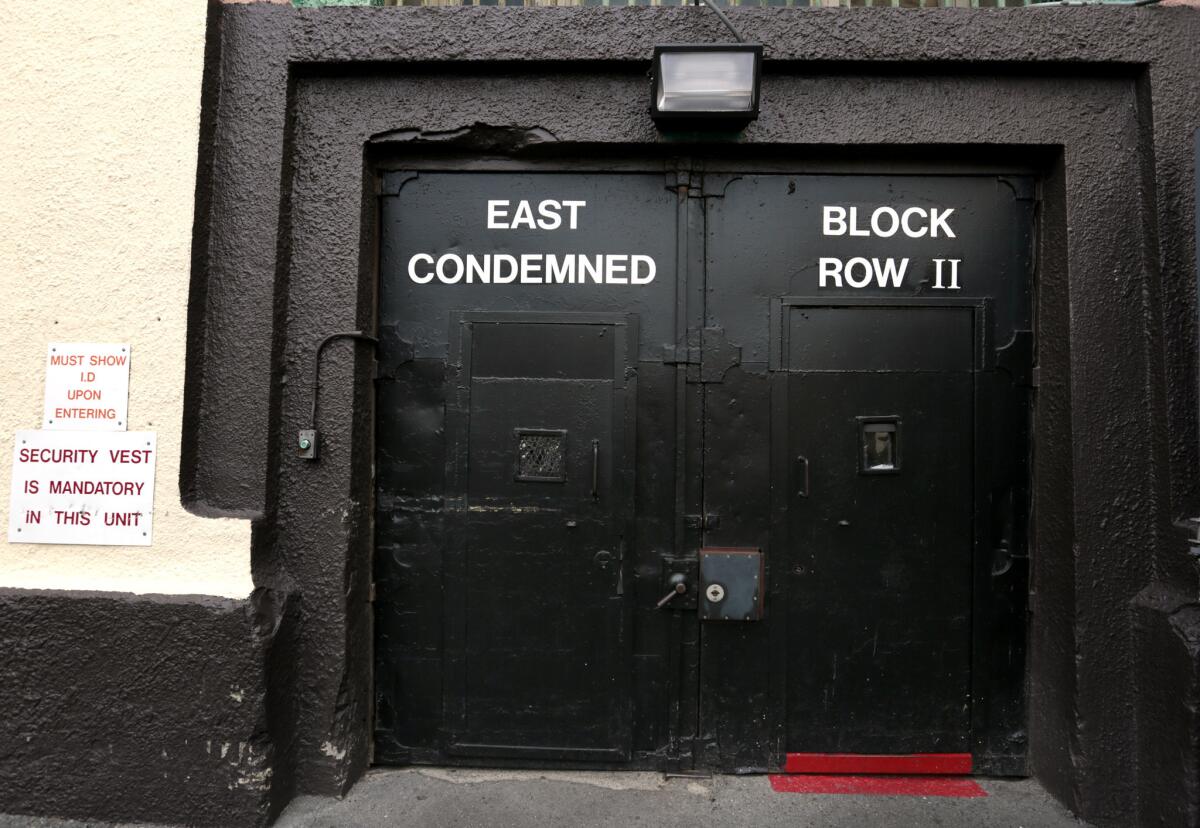Opinion: Appellate decision on California’s death penalty doesn’t end the fight

The entry to the East Block Condemned Row at San Quentin State Prison, part of the state’s death row that holds 747 condemned people. The 9th Circuit Court of Appeals has overturned a lower court ruling that the death penalty system is unconstitutionally dysfunctional. But it did so on procedural gorunds, leaving the analysis un-reviewed.
- Share via
The U.S. 9th Circuit Court of Appeals on Thursday kicked back a district court ruling that inherent delays in California’s death penalty make it arbitrary, and thus unconstitutional. But the three-judge appellate court didn’t weigh the merits of the arguments -- it overturned Judge Cormac J. Carney’s ruling on procedural grounds. The details are a bit arcane, but the brave can dive into the decision here.
In one sense, the decision is a loss for those hoping for an end to the death penalty (me among them). But it’s also a non-decision because the appellate judges didn’t take up the heart of Carney’s ruling, and his logic is quite compelling. In a nutshell, the very structure of California’s death penalty means that who among the condemned actually gets put to death is determined by an arbitrary process that drags out so long that the execution serves neither as a deterrent nor as an act of retribution, important thresholds under previous Supreme Court decisions.
That argument is still out there, even if the appellate court decided it couldn’t review it.
That argument is still out there, even if the appellate court decided it couldn’t review it under court rules established under the Clinton-era Antiterrorism and Effective Death Penalty Act of 1996.
“The rule is that the federal courts can reverse the state criminal cases for constitutional violations only if the law is ‘well established,’” says Natasha Minsker, director of the ACLU of California’s Center for Advocacy & Policy. “The idea is that the state courts can only be expected to implement federal rules that they know about. The state courts can’t be expected to guess how federal judges will interpret the constitution in the future. The problem: That prevents the federal courts from addressing constitutional violations in many criminal cases.
“It’s sort of like instant replay in sports before you could review a call. The ref makes a call, everyone watching at home sees it was a mistake, but it couldn’t be fixed.”
I wrote about Carney’s ruling shortly after it came out last year, and it was clear then that it faced a difficult fight at the appellate level because it is, in fact, a novel assessment of the inherent dysfunction of California’s death penalty system. What wasn’t clear was the likelihood that the appellate court would reject the ruling on procedural grounds. But that’s where it stands, with appellate judges saying they don’t have authority to assess and rule on the merits of Carney’s decision.
That’s unfortunate. Analysts say the argument could be raised before the state Supreme Court, which would change the legal trajectory and the procedural issues. But it will be a challenge. (There are other problems with the death penalty system, which Ronald M. George, former California chief justice, wrote about in this piece from 2008).
For people not versed in the minutiae of court rules and procedures, this is another place where the credibility of the legal system crumbles. If the appellate courts can’t be led to address the basic question of whether the design and implementation of the state’s capital punishment is unconstitutional because it engenders decades-long delays between the crime and the punishment, and the ultimate decision of who gets put to death when is arbitrary, then where does that argument get aired?
Of course, this could all be rendered moot by California voters. Or, conversely, made more objectionable. Pro- and anti-death penalty advocates have filed initiatives for the 2016 ballot. One would ban the death penalty. The other would speed up the process and narrow the sorts of appeals that can be argued (which also would increase the risk of the wrongfully convicted getting executed before the truth could be found). Neither has been cleared yet for circulation, and either can still be withdrawn.
But it’s clear this fight will continue -- and may still yet get another look by the Supreme Court.
Follow Scott Martelle on Twitter @smartelle.
MORE FROM OPINION
No safe space for reporters at University of Missouri protest
T-Mobile’s unlimited video streaming is not a net neutrality problem
If L.A. wants to be a world class city, it needs to stop micromanaging its public spaces
More to Read
A cure for the common opinion
Get thought-provoking perspectives with our weekly newsletter.
You may occasionally receive promotional content from the Los Angeles Times.










